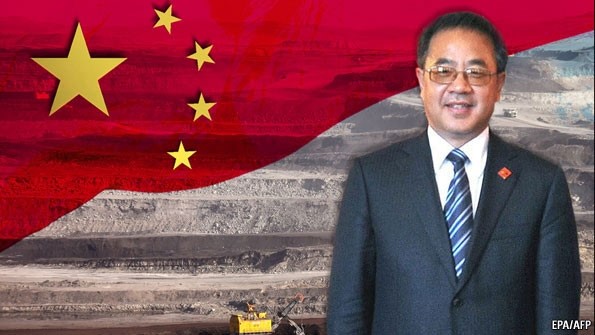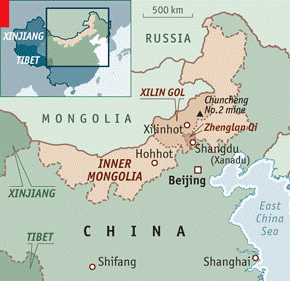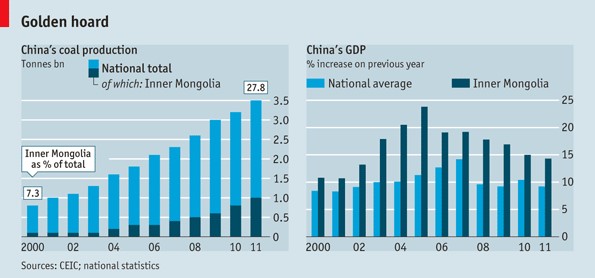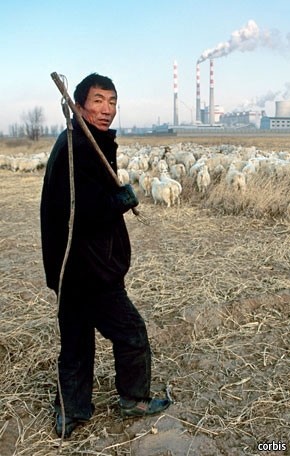

 字體:小 中 大
字體:小 中 大 |
|
|
|
| 2018/05/12 01:13:58瀏覽66|回應0|推薦0 | |
Inner MongoliaLittle Hu and the mining of the grasslandsSoaring demand for a region’s minerals stirs unrest and brings challenges for a rising political starJul 14th 2012 | HOHHOT AND XILIN GOL | from the print edition
LOCAL legend has it that the beauty of the grasslands in Xilin Gol, a prefecture in eastern Inner Mongolia, so captivated the 13th-century warrior Genghis Khan that he planned to settle down there once his battles were over. He might be less impressed if he saw it today. In recent years a rush to mine the region’s abundant minerals has scarred its hills, desiccated its pastures and fuelled unrest among its Mongol herders. For the local Communist Party chief, Hu Chunhua, who many believe is being groomed as a future leader of China, these are difficult times. At 49, Mr Hu is China’s second-youngest provincial party chief. He is a likely candidate for elevation to the ruling Politburo when China’s “fifth generation” of leaders assumes power in the autumn. He is also widely believed to be close to President Hu Jintao. The two men are not related, but Inner Mongolia’s leader is sometimes referred to as “Little Hu” because of the two men’s similar political backgrounds. As the president once did in Tibet, the younger Mr Hu is preparing for higher office in a border region with a sizeable ethnic-minority population. He is thought to be President Hu’s favourite to head the “sixth generation” of leaders that is expected to take over in 2022. Little Hu’s record in Inner Mongolia will help determine whether he succeeds. When Mr Hu took up his post in 2009, it might have seemed a cushy assignment. Inner Mongolia’s backward economy was booming thanks to demand for its minerals, ranging from copper to rare earths, but especially its coal. Its ethnic Mongols were far less rebellious than the unruly Tibetans upon whom Hu Jintao imposed martial law in 1989 when he was Tibet’s party chief (Hu Chunhua, who is described in official hagiographies as a fluent Tibetan speaker, was there at the time, too, as a junior official). Inner Mongolia has long been a majority ethnic-Han province, with Mongols making up less than 20% of its 24.7m people (several hundred thousand of them are herders). In May 2011, however, Mongols in Xilin Gol, a sparsely populated prefecture about the size of Britain, rattled Mr Hu by staging the region’s biggest protests in 20 years.
The mining, it turned out, was fomenting instability. By 2009 Inner Mongolia had become China’s largest producer of coal. It is the biggest source of the world’s supply of rare earths. The coal bed around Xilinhot, the capital of Xilin Gol, boasts 38% of global reserves of germanium, a rare earth used in the making of circuitry for solar cells and wind turbines. Ripping up the grasslands and sucking up scarce water for thirsty mines has been part of the price of these “green energy” products. Boomtown spats Flying into Xilinhot offers a panoramic view of the devastation. Vast open-pit mines that spew clouds of dust into the air scar a landscape that locals say was largely pristine only a few years ago. The coal-driven boom has transformed the city. In the past six years its built-up area has expanded by more than 60%. In 2007 work was completed on a square nearly the size of Beijing’s Tiananmen, with a statue of Genghis Khan on a towering pedestal at its centre. People’s Daily, the Communist Party’s main newspaper, said that a Chinese company had helped cover the cost of the square and a new museum next to it (estimated at around $50m by Xinhua, a state news agency) in return for a cheap-rate mining concession. Land disputes between miners and Mongol herders became commonplace. In a typical incident, in May 2011, a group of Mongol herders was trying to stop mining lorries crossing and churning up grassland near their homes about 110km (70 miles) north-east of Xilinhot. During the night, a lorry driven by an ethnic Han Chinese driver hit one of the herders, called Mergen (single-named, like many Mongols). It dragged him over the grassland for 150 metres, killing him. Mergen’s death ignited long-festering grievances among the herders. Protests first broke out in the nearby county town, then spread to Xilinhot where hundreds of high-school students in yellow and blue tops marched through the city to the steps of the prefectural headquarters near Genghis Khan’s statue. The students, in their late teens, were mostly Mongol herders’ children. Unlike their ethnic-minority counterparts in Tibet in 2008 and the Uighur people in the north-western region of Xinjiang in 2009, whose anger erupted into violence against Han Chinese, the Mongol protesters avoided any action or demands that smacked of ethnic conflict. They mainly demanded better measures to protect herders’ property rights and the environment, and the punishment of those responsible for the killing. The protests spread as far south as Zhenglan Qi, an area famous for the overgrown ruins of Kublai Khan’s capital, Shangdu (or Xanadu, as it is known to Coleridge-reading foreigners). The protesters’ concerns may have seemed innocuous, but the authorities feared that they might open up a new front of nationalist unrest among non-Hans. Mr Hu, the region’s party chief, reacted with a display of might reminiscent of the tactics often used in other, far more volatile, ethnic-minority regions. Paramilitary police were deployed in towns across Xilin Gol. In the provincial capital, Hohhot, university students were temporarily barred from leaving campuses and the central square was sealed off by security forces. Such a response doubtless earned Mr Hu praise among stability-obsessed leaders in Beijing. Since the unrest, he has shown no sign of loosening his grip. The police are continuing to keep an Inner Mongolian activist, Hada, in what appears to be illegal detention, mostly incommunicado. Hada was released from prison in 2010 after serving a 15-year sentence for “separatism” and spying. Towards those deemed less of a political threat, Mr Hu has been more conciliatory. In Xilin Gol he tried to win the support of the prefecture’s 200,000 Mongol herders by meting out severe punishment to the offending lorry driver (who was executed) and his co-driver (who was sentenced to life in prison). Mergen’s family was given substantial compensation, neighbours say. The open-cast Chuncheng No. 2 mine near their village, along with dozens of other mines in Xilin Gol, was ordered to close, at least temporarily. The county’s party chief was dismissed. On July 2nd this year a court in Beijing sentenced a former party chief of Xilin Gol, Liu Zhuozhi (who had become Inner Mongolia’s deputy governor), to life in prison for taking bribes, some of which related to Xilin Gol’s mining bonanza. During the unrest, Mr Hu flew out to Xilin Gol to talk to students at a school near the herder’s home. “If the interests of the masses are not well protected, development cannot be sustained,” he said. His remarks contrasted with the much harsher tone of official rhetoric in response to the unrest in Tibet in 2008 and Xinjiang in 2009. Authorities there blamed the upheavals on agitators based abroad and, unlike Mr Hu, avoided any suggestion that there could be legitimate grievances.
Reining it in This year, after years of torrid growth (a tenfold increase in provincial coal production—see chart—and a 94-fold increase in Xilin Gol, in the past decade), the Inner Mongolian government promised for the first time to “control” its coal output, which in 2011 was roughly the same as America’s. But it is unclear whether local governments have got the message. Xilin Gol’s latest five-year economic plan, approved early last year, calls for a doubling of coal output by 2015. Big mines like the one being developed near Mergen’s home (which has a projected investment of nearly $1 billion) will be beneficiaries. A sign pointing to it has been blacked out, but residents of the area say they expect it to be allowed to reopen once it has finished building a better road across the grassland. As for the smaller, unlicensed mines, says an ethnic Mongol academic, “even if the government wants to bring them under control, it can’t.” The mine-owners, he says, often use shady connections with local officials to avoid being shut down. To the herders, mining brings few obvious benefits. Over the past decade, thanks largely to the rush for resources, Inner Mongolia has recorded the fastest GDP growth of any Chinese province (17% annually on average between 2001 and 2011—see chart). But mine workers are mostly hired from elsewhere, says Sun Xueli of the Inner Mongolia Academy of Social Sciences. Herders also find it hard to find jobs in Inner Mongolia’s prospering cities. Their mother tongue, Mongolian, is unintelligible to most Hans. Some hotels in Hohhot forbid staff from using it, says a Mongol academic. Government efforts to protect the grasslands from over-grazing are not making the herders’ lives any easier. Even as money-spinning mines have proliferated, restrictions have been imposed on grazing. Over the past decade the government has moved more than a quarter of Xilin Gol’s herders off poor-quality grassland into agricultural or urban jobs. But the policy is resented by some Mongols as an attempt to eliminate herding, which they say the government regards as backward.
No pleasure-domes here (pictures)
It remains unlikely that the herders’ discontent will erupt into the kind of separatist unrest that has periodically roiled Tibet and Xinjiang. Mongols in Inner Mongolia see little attraction in unification with the far poorer Mongolian republic to the north (and few in the republic show much interest in expanding their territory southward). The region has no rallying figure abroad like the Dalai Lama or the Uighur exile Rebiya Kadeer. But grievances over the environment and land rights are widespread across China, as shown last week by large-scale and violent protests against the building of a copper-alloy factory in the south-western city of Shifang. Even if most Mongols are not yearning for independence, Mr Hu cannot relax. In Xilinhot eight years ago the authorities removed a monument to Communist heroes which stood atop a hill in the city, and reinstated 13 Mongolian ovoo, or stone mounds, that are used in traditional worship (the original ovoohad been flattened by Mao’s Red Guards). Residents say the government’s aim was to bring good luck, but many regret that the once verdant view from the hill, looking away from the city, is now a mine-scarred dust bowl. “They came like ants and ruined it,” says a Han Chinese resident. Yet Mr Hu is unlikely to get black marks for that from the nation’s leaders in Beijing. from the print edition | China Little Hu and the mining of the grasslands Jul 14th 2012, 10:23
I’m very glad to see this analysis occupying the whole column to indicate the current tide of arrangement in China’s Communist party (CCP). Last June when I commented on the Economist, I talked of Hu Chun-hua - along with Hunan party’s chief Zhou Qiang - who was a key role in forming six-generation CCP. Now the Economist offers the readers a visionary analysis to discuss China’s fate, very excellent. Given no problem, Little Hu can be central party’s secretary and President after Xi Jin-ping while Zhou may get promotion to next prime minister after Li Ke-qiang. Little Hu, Zhou and Li belong to the CCP’s Youth League (CCYL), the same faction as incumbent President Hu Jing-tao and prime minister Wen Jia-bao.
In 2012’s round, CCYL shows the less grade of faction than princeling party. At the present, CCP gets “compromising” balance between CCYL and princeling party. CCYL Two weeks ago, under the circumstance bad for the current President Hu, Guo Jin-long - President Hu’s No.1 assistants - was promoted to Beijing’s party chief, an indication of interior CCP’s wax and wane. The friction between CCYL and the princeling party increased as the upcoming 18th CCP’s central committee and Polituburo. However, as I know for several years, Xi dislikes President Hu’s surrounding assistants and Little Hu’s promotion, also keeping away from Li’s faction (including Wang Yang and me). Xi and Li’s buffering solution is Li Yuan-tsaou.
Basically, China’s rebellion includes Tibet, Xinjiang and Mongolian aspects. Inner Mongolia recently grow fast of coal and rare earth with railway transport, but the unrest still happen with rumor owing to few cause. Little Hu works at the border of China as a supervisor keeping silent among China’s bureaucracy. For several years, Little Hu actively turns the poor situation into the wealthier ones in Inner Mongolia. Little Hu few has relation with the current central CCYL (President Hu), the pan-CCYL (Li Ke-qiang) or princeling party (Xi Jin-ping). But, very soon, Little Hu can award advance of higher seat so that Little Hu stands at the similar level of the current these three in the near future. Likely, Little Hu may make good use of the transportation of industrial resource between Mongolia and Inner Mongolia that becomes his own safe bet for his promotion.
Time is like an arrow. According to Dr. Yang Zong-mei’s “Xi’s Biography”, about ten years ago, Xi was reported by Financial Times, requested for the possible utmost seat of leader. “Really, I am so surprised”, Xi answered. At that time, Xi was just a local officer working as Xi’s affiliation was expanding the influence in wealthy South-eastern coast. Now, for Little Hu, the destiny to have chance for progress comes. However, although Little Hu’s grade is pretty well, so far, when it comes to economic growth as well as the moderate attitude toward Beijing centre, as I know, Xi is reluctant to agree on Little Hu and Zhou Qiang’s possible promotion plan. That is to say, there are much uncertainty of these sixth-generation CCP’s future.
In media’s aspect and instead of the past, CCTV and Xinhua report less about the power transition. Nor does current Taiwanese media, which gets worsen. Traditionally, some information could be seen in CCTV and Xinhua or we can some release in Taiwan’s media; nowadays, interestingly, oversea book or magazine have more relative reports than CCTV and Xinhua.
The fifth and possible sixth-generation CCP, as their previous seat shown, have some good grade of experience, although they have yet enjoyed the fame as third or fourth CCP. On the surface, few winds of change may occur in this time’s power transition, but, at a crossroads of China’s history - in the process of economics restructuring and interior plus exterior political challenge - the sustainable social surroundings must be ensured for the longer road to the future. No one wants to see another miserable sufferings as this global economic generator - Asian dragon - flies toward the ultimate in the world.
“Neither I see the sun through clouds in the sky in the future. And I neither find the promised heaven nor regretfully sigh your so-called ordinary-livings, which is neither here nor there, let alone 3-inch light of sunshine. That heaven is the place where I have loved you.” While Yan Yi-dan’s (Ivy Yan) “Three Inch Heaven” of “Each Step Escapes” echoes, the real version of story in CCP is in the process of moving forward to lead Chinese.
At the moment of 2012-2013 power transition, one more time, I exclaim the rapidly passing time which always walks along the prosperity and people’s willingness to better welfare. I watch the post-Deng power transition and Taipei’s political arena since I was very young. As one of the political transformation in China’s limitless river of memory, I listen to Hu Ge and alan’s “The persistence of thoughts”, the reflection on almost of royal palace’s stories in Chinese long-term history.
Recommended 6 Report Permalink
這篇是經濟學者雜誌對於胡春華的仕途,在當年持正面積極的看法,因此花了所有當期中國版的篇幅介紹這位北京大學中文系畢業,在筆者閱讀楊中美博士時還在當「共青團第一書記」,在第六代裡面數一數二年輕,1960年代(1963年出生)的領導人。當時胡春華正在擔任內蒙古自治區區委書記,國際上中國關係的學界當年會有這種接班的猜測是跟共青團的傳承有很大的關係。李克強在擔任共青團第一書記後是胡春華和周強接棒。筆者在這篇的前一年有介紹過胡春華、周強和孫政才,之後還有一名,在周強確定從湖南省委書記,提前升至全國最高法院院長,由2015年學界公推曾經在就讀北京大學的時候,擔任第一次全校學生投票出來的學生會長的陸昊,現任黑龍江省委書記。很巧合的,筆者就讀的長庚大學醫學系同學張惟翔就是和胡春華五親等關係,張同學在胡任縣長時去大陸省親過,而陸昊是筆者讀何嘉仁美語補習班的同班同學、新莊國中、建國中學和長庚大學醫學系的學長陳繹中(綽號UFO,英語名字是Steve)的五親等的,也是在陸昊創辦中關村時有去省親過,及其後一次。另外筆者服替代役時的同梯同大隊的王力弘先生(綽號肥肥)及其父是在福建省跑買辦很尋常的商人,王家和習仲勛及習近平、習近武家人是在蔣經國還沒開放大陸探親前,就在1980年初期開始,是數十年舊識。這世界對筆者來說真是非常奇妙。 內蒙古在1990年代初期,蒙獨的陰謀不斷,在1997年首謀被補(2014年獲釋,為中共列黑名單者僅剩岑賴在蒙古國烏蘭巴托流亡,其他不知去向),相對來說,到了2005年時,創近25%經濟成長的歷史新高,於是穩固了中共在這裡的統治,但相對來說因為接受中共混合經濟政策,這經濟成長也使當地的自治權受限,在這篇作成後,胡春華要離開內蒙至廣東省述職之際,中學生發生暴動,雖尚未到宣稱尋求獨立的叛離地步,但是大規模的集結曾經讓交通工廠癱渙,訴求於工資和基本設施的不足,因此對政府比較沒了信心,並懷疑仍然高成長的背後不是有人灌水,就是貧富差距過劇。筆者並不會認為是胡春華的問題,到了他上任廣東省委書記時,胡的能力有重於協調,而比較不會有城鄉和貧富差異,是作廣州、深圳、珠海的創意轉型及各二線城市現代化程序,以利和香港形成珠三角經濟地帶(廣州、深圳、佛山、東莞、中山、珠海、惠州、江門、肇慶)。不過省經濟成長就創了1990年以來的歷史前幾名低點了。 拉回來最近看到胡春華的政治上的職位,據一兩周前陳破空接受三立電視新聞台的廖筱君主播專訪,王滬寧的位置有可能因為習近平的聲勢稍弱,有曾經聽聞會由本來在預期上是第六代的2022-23的接班的胡春華在年底左右接手。如果就筆者附近所知,是數十個省級幹部們,以省委書記委主和中央距離變的很遠,又因為中央的絕對權威在年初時經過修憲,新形成的壓力使中共和中華人民共和國形同一個國家統治另外一個國家。而習近平的權威在今年策略上,仍然以軍務上督導和黨政的主導為主體,不過由於中美貿易和國際上的對於軍事擴張疑慮,展現於南海和太平洋事務,這個替換人選的說法不無可能,筆者的確之前耳聞過。 有關胡春華先生從基層幹部的政績,筆者曾經在三民書局復興北路店看到(現在於博客來網路書店仍可購得)香港明鏡出版社於2010年10月1日出版的,任華一先生所整理「第六代:中共末代接班群」(ISBN: 9781935981022)內人物的施政表現、數據及民間與共黨中央當年的官方文書上評價與收錄。這本當時該社和習近平、李克強的書,「中國掌權者叢書」共三本並列,前瞻性還夠,比如作者就問起最早被溫家寶相中的孫政才,因一些個性上問題,是否能笑到最後,一路亨通,這個問題提得很好,果然去年就被揭發有涉及貪汙被捕了。而周強所建設的大長沙地區,的確和江西南昌與湖北武漢,今天連成長江中游經濟帶,僅次於環渤海、長三角和珠三角地帶。書中所提出的焦點是還有陸昊,筆者更在這篇數年後,當經濟學者雜誌也矚目陸昊是繼胡春華之後,年過半百的政治新星時,除了李克強總理上任那週時在討論區寫了一篇之外,也趁機作了一篇陸昊的傳記。以後再繼續回顧前幾些年的文章時,筆者會再作著墨。 回顧起那年,胡春華相對上是當年被稱為習近平的下一任,就資歷上及黨內大老的想法,受胡錦濤欽點接班,但是並沒有獲得習近平及其附近近臣的同意。胡的出身背景是共青團派,和胡錦濤及李克強同源,但是習近平基本上不喜歡以共青團歷練及實習的成績作為唯一依據,又習信任「之江新軍」,即習會採用從浙江與福建省,及父親習仲勛舊部出身的官員進京或作升遷,因此不太會再循舊例作人事調整。當年在大部份是太子黨的興起同時,郭金龍升至北京市委書記,算是從北京奧運後五年多內團派最後的反撲。根據楊中美博士寫的「習近平傳」,當年習近平是從英國金融時報2003年的詢問,確定外媒的判斷習為唯一的人選,習問了一聲「真的!?」,而今天看胡春華就相對沒有那麼篤定了。目前胡春華是任副總理,和同為團派,從1990年在上海市領導層歷練有的第一副總理韓正同在中央領導層內,但沒有在2017年底被升為政治局常委。但胡春華的仕途並沒有止步,比如近月來的幾項可能除了上述外,還有四年後韓正有可能再升上去,而胡春華則是韓的副手。一般地方領導及年輕國企幹部,仍然希望胡春華和陸昊(有國企幹部的歷練過,如北京中關村1990年代上半期的建成),約現今五六十歲間的,在十年內有更好的發展。 |
|
| ( 心情隨筆|心情日記 ) |














